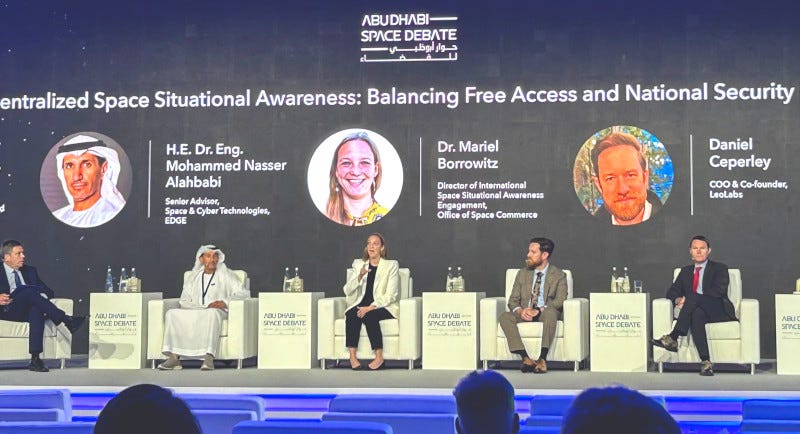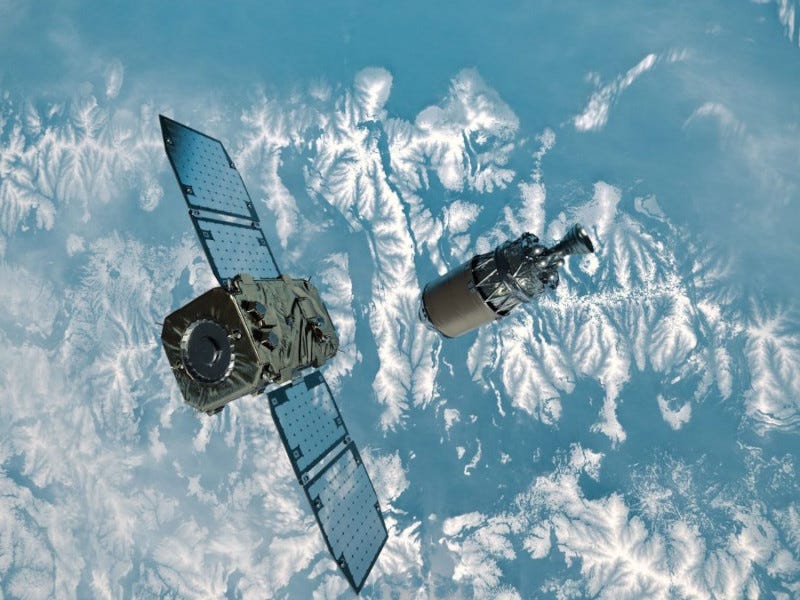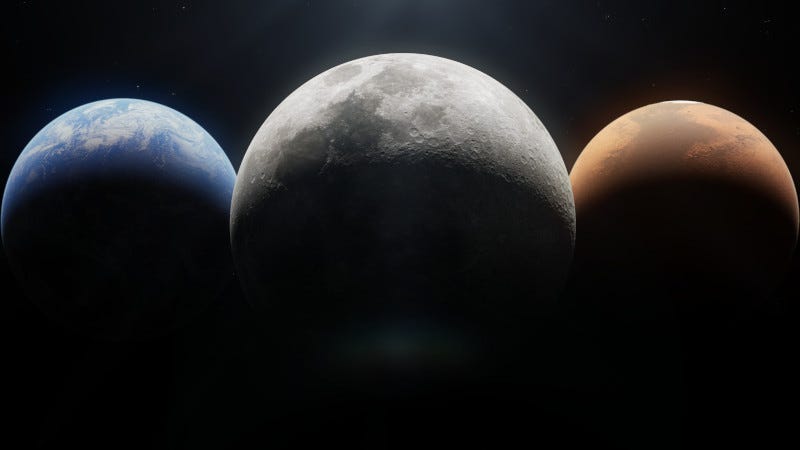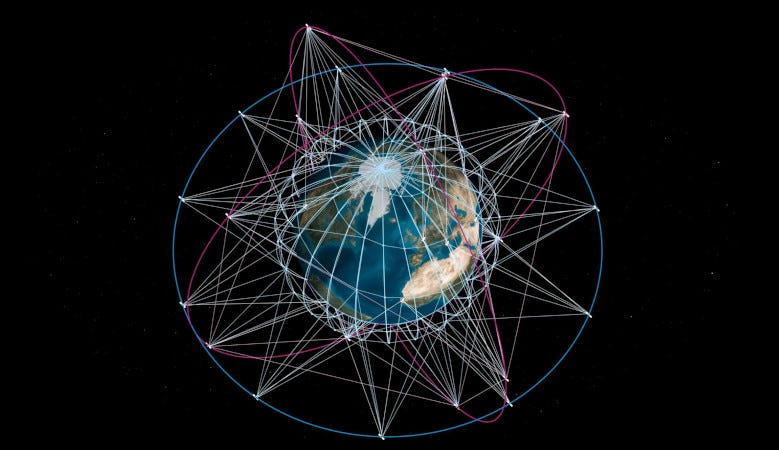Earlier this month, the Office of Space Commerce’s Gabriel Swiney and Mariel Borowitz joined key U.S space diplomacy efforts in the United Arab Emirates.
First, OSC participated in a U.S. space trade mission to UAE, organized by the U.S. Chamber of Commerce. The delegation visited the Mohammed Bin Rashid Space Center in Dubai, engaging with international partners and the UAE space sector in preparation for the Abu Dhabi Space Debate on December 10-11.
The discussion explored critical topics around decentralized SSA, including mechanisms to share the consequential data for spaceflight safety. Specifically, Borowitz shared updates on the TraCSS initiative’s open data policy, emphasizing the role of data sharing and international cooperation in building a transparent and collaborative SSA framework.
According to the OSC, as the United States is developing the TraCSS system, many other nations and organizations around the world are also developing or improving their own SSA capabilities. As these developments continue, the Office of Space Commerce is committed to maintaining an open and transparent system that enables global coordination with other SSA providers and ensures reliable and efficient services to global spacecraft operators.
-0-
Blue Origin’s payload for New Glenn’s first mission, NG-1, is ready for launch this year. NG-1 will carry the company’s Blue Ring Pathfinder and mark the rocket’s first National Security Space Launch certification flight. The encapsulated payload will be integrated onto the launch vehicle following the hotfire. New Glenn will lift off from Blue Origin’s Launch Complex 36 at Cape Canaveral Space Force Station.
The pathfinder was developed by Blue Origin’s In-Space Systems business unit. It will test Blue Ring’s core flight, ground systems, and operational capabilities. NG-1 will carry the Blue Ring Pathfinder payload as part of the Defense Innovation Unit’s (DIU) Orbital Logistics prototype effort. DIU funding is helping to enable future Department of Defense missions.
The demonstrator includes a communications array, power systems, and a flight computer affixed to a secondary payload adapter ring. The pathfinder will validate Blue Ring’s communications capabilities from orbit to ground. The mission will also test its in-space telemetry, tracking and command hardware, and ground-based radiometric tracking that will be used on the future Blue Ring production space vehicle. The pathfinder will remain onboard New Glenn’s second stage for the duration of an expected six-hour mission.
-0-
The commercial debris inspection demonstration satellite, Active Debris Removal by Astroscale-Japan (ADRAS-J), recently successfully approached a large piece of space debris ... a rocket upper stage ... to approximately 15 meters, or just under 50 feet. This is the closest approach ever achieved by a commercial company to space debris through Rendezvous and Proximity Operations (RPO).
When ADRAS-J was 50 meters behind the upper stage the spacecraft reduced the gap in a straight-line approach then maneuvered to approximately 15 meters below the Payload Attach Fitting (PAF) — the planned capture point for the follow-on ADRAS-J2 mission — aligning the spacecraft’s relative speed, distance, and attitude. ADRAS-J successfully maintained this position until an autonomous abort was triggered by the onboard collision avoidance system due to an unexpected relative attitude anomaly with the upper stage. The spacecraft safely maneuvered away from the debris as designed before reaching the CIP. Astroscale Japan is currently investigating the cause of the abort.
While ADRAS-J did not reach its intended final distance, the mission demonstrated the robustness of its safety measures during simulated capture operations. The onboard Fault-Detection, Isolation, and Recovery system has ensured the spacecraft’s safety during all close-proximity operations, including the successful response and abort maneuver during the first fly-around observation attempt in July.
-0-
As NASA develops a blueprint for space exploration throughout the solar system for the benefit of humanity, the agency had released several new documents updating its Moon to Mars architecture. The roadmap sets NASA on course for long-term lunar exploration under the Artemis campaign in preparation for future crewed missions to Mars.
Following an Architecture Concept Review, the 2024 updates include a revision of NASA’s Architecture Definition Document which details technical approaches and processes of the agency’s exploration plans, an executive overview, and 12 new white papers on key Moon to Mars topics.
One newly released white paper highlights NASA’s decision to use fission power as the primary source of power on the Martian surface to sustain crews — the first of seven key decisions necessary for human Mars exploration. Fission power is a form of nuclear power unaffected by day and night cycles or potential dust storms on Mars.
New additions this year also include a broader, prioritized list of key architecture decisions that need to be made early in NASA’s plans to send humans to the Red Planet.
-0-
An agreement has been signed between the European Commission, ESA and SpaceRISE ... a consortium comprised by Eutelsat, Hispasat and SES ... that will see the consortium design, deliver and operate the Infrastructure for Resilience, Interconnectivity and Security by Satellite (IRIS²) for a period of 12 years. The contract was signed today in a ceremony at the European Commission headquarters in Brussels.
With the network of 290 new Low Earth Orbit and Medium Earth Orbit satellites expected to provide services by the beginning of 2030, the IRIS² constellation of satellites for a resilient, interconnected and secure Europe is an EU flagship initiative. IRIS² will be the preferred and trusted network for Europe in delivering secure and reliable high-performance communication solutions to the EU and its Member States as well as high-speed broadband connectivity for European citizens, governmental authorities and businesses, playing a transformative role in reinforcing Europe’s digital sovereignty, and low-latency connectivity.
Under the agreement with SpaceRISE, the project will be backed by €6.5 billion (≈$6.83 billion) of public funds representing nearly 60% of the total project costs – comprising funding from the European Commission, EU Member States, the European Space Agency and private financing from the consortium members. The SpaceRISE consortium will lead the wider European space industry to accelerate innovation throughout the supply chain, enhancing Europe's leadership and competitiveness in the space sector.
And those are some of the top stories from The Journal of Space Commerce this week. I'm Tom Patton

















